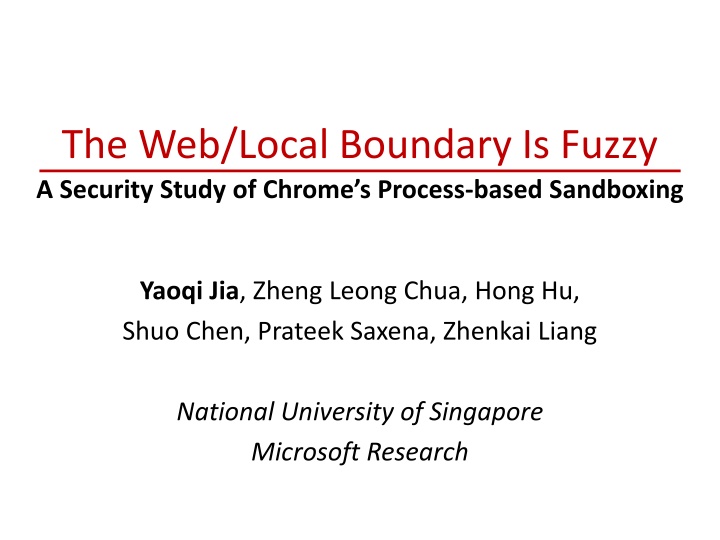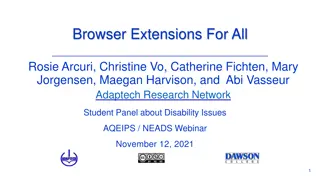Security Study of Chrome's Process-based Sandboxing
Investigate the effectiveness of process-based sandboxing in modern browsers like Chrome, focusing on the fuzzy boundaries between the web and local systems. The study explores vulnerabilities and potential attacks, proposing lightweight solutions to mitigate risks presented by imperfect existing security measures.
Download Presentation

Please find below an Image/Link to download the presentation.
The content on the website is provided AS IS for your information and personal use only. It may not be sold, licensed, or shared on other websites without obtaining consent from the author.If you encounter any issues during the download, it is possible that the publisher has removed the file from their server.
You are allowed to download the files provided on this website for personal or commercial use, subject to the condition that they are used lawfully. All files are the property of their respective owners.
The content on the website is provided AS IS for your information and personal use only. It may not be sold, licensed, or shared on other websites without obtaining consent from the author.
E N D
Presentation Transcript
The Web/Local Boundary Is Fuzzy A Security Study of Chrome s Process-based Sandboxing Yaoqi Jia, Zheng Leong Chua, Hong Hu, Shuo Chen, Prateek Saxena, Zhenkai Liang National University of Singapore Microsoft Research
Monolithic Browser Design Web Page EXE Local System Files Apps Sensors 1
2nd Generation Browser: Process-based Isolation Process-based sandboxing process boundary Web Page Web/Local Boundary Browser kernel Local System 2
Is the Web/Local Boundary Sufficient? Used by most modern browsers Web Page B Web Page A Web/Local Boundary Browser kernel Local System Stress testing, bug bounty, fuzzing 3
Contributions The Web/Local Boundary is Fuzzy ! Concrete Access local files, system control Use 1 bug in renderer process Attacks Attack Bypass in-memory protections using data-oriented attacks Details Imperfect existing solutions Our light-weight mitigation Solutions 4
The Web/Local Boundary is Fuzzy Landscape changes --- Rise of the cloud services Before 2016 Web Page Fuzzy Cloud Web/Local Boundary A new path to access local system Browser Kernel Local System Client 5
Attacks due to Fuzzy Web/Local Boundary 6
Attack Example 1: Drop a Malware www.evil.com Dropbox Cloud Browser Kernel Local System Dropbox Client 7
Example 2: Steal a Local File www.evil.com Dropbox Cloud Browser Kernel Local System Dropbox Client 8
Example 3: Install Malware www.evil.com Google Play Server Browser Kernel Local System (Android) Google Play 9
Example 4: Remote System Control www.evil.com rm -rf / OpenStack Server Browser Kernel Local System (VM) OpenStack 10
But Chromes Protections Same-Origin Policy (SOP) Control-Flow Integrity (CFI) on the way In-Memory Partitioning Internal Randomization 11
SOP Enforcement in Chrome www.evil.com bool SecurityOrigin::canAccess() { if (m_universalAccess) return true; if (this == other) return true; ...... return canAccess;} SOP Checks www.dropbox.com Various SOP checks for cross-origin read/write: contentDocument, frames, etc. 12
Control-Flow Integrity CFI: control flows cannot be modified (on the way) <func1> lea func2, %eax jmp *%eax Check1 Check2 <func2> push %ebx Check3 13
Bypass SOP & CFI Corrupt critical data Not modify control flow Bypass SOP checks bool SecurityOrigin::canAccess() { if (m_universalAccess) return true; if (this == other) return true; ...... return canAccess; } Check1 True Check2 True When m_universalAccess is true, the check always passes Check3 True 14
In-Memory Partitioning Separate different types of objects in 4 partitions Surrounded by inaccessible guard pages Different Objects Guard Page Node Layout Buffer General 15
Cross-Partition References to Bypass Partitioning Link objects in one partition to another Pervasive & often under the control of scripts Dereference pointers to cross partition boundaries General Buffer Layout Node 16
Partition-based Randomization Randomize the base address of each partition Guard pages cannot be read/written Node Layout Buffer General 17
Fingerprinting Technique to Bypass ASLR & Find Critical Data Special pattern for security monitor objects Linearly scan memory class PLATFORM_EXPORT SecurityOrigin { ...... String m_protocol; String m_host; String m_domain; String m_suboriginName; unsigned short m_port; bool m_isUnique; bool m_universalAccess; bool m_domainWasSetInDOM; bool m_canLoadLocalResources; bool m_blockLocalAccessFromLocalOrigin; bool m_needsDatabaseIdentifierQuirkForFiles; }; protocol host B9 BB 88 20 B9 CC 91 10 B9 CC 91 10 00 00 00 00 00 00 00 00 00 00 00 00 Match the pattern domain suborigin 01 m_universalAccess 18
Find the Address of Vulnerable Array Create a predictable fingerprinting object Linearly scan memory to find the object s location Count the offset when finding the pattern B9 DD 11 10 41 41 41 41 41 41 41 41 Vulnerable Array Offset Fingerprinting Object Most frequent data is the address of fingerprinting object Object Pointer B9 DD 22 30 B9 DD 22 30 B9 DD 22 30 B9 DD 22 30 Object Pointer Addrbase = Addrobj- Offset 19
Bypass SOP & In-Memory Protections SOP Data-oriented attacks Seems difficult to bypass CFI Data-oriented attacks In-memory partitioning Cross-partition references Internal ASLR Fingerprinting technique 20
Attack Implementation Work on proper memory error vulnerabilities POC: CVE 2014-1705 heap overflow in V8 (Chrome 33) Over 10 SOP-related flags (Chrome 45) End-to-end attacks Access files on the local system Dropbox, Google Drive Interact with local system OpenStack, Google Play Misuse system sensors Fitbit, Runkeeper 21
Web Browser-Side Protection Memory safety Huge code base, e.g., +5 million LOC for Chrome Software-based fault isolation (SFI) Cross-partition references General Buffer Layout Node 23
Light-Weight Mitigation Identify critical data ASLR to hide the address of critical data Address of the critical data is not saved in user space Average 3.8% overhead Raise the bar of Web/Local attacks General Buffer Layout Node 24
Disclosure to Google Fine-grained process-based isolation Chrome s Out-of-Process iframes Performance overhead and massive refactoring www.evil.com www.evil.com www.dropbox.com www.dropbox.com 25
Cloud Service-Side Protection Distinguish requests of its site from client Restrict the privileges for the web interface Require the user s consent Web Page Cloud Web/Local Boundary Browser Kernel Local System Client 26
Conclusion Concrete Attacks on Web/Local Boundary Access local files, system control Using 1 bug in renderer process Attack Details Bypass in-memory protections Video at https://youtu.be/fIHaiQ4btok POC at https://github.com/jiayaoqijia/Web-Local-Attacks Solutions Imperfect existing solutions Open to researchers 27
Thanks Yaoqi Jia (Graduating in 2017) jiayaoqi@comp.nus.edu.sg http://www.comp.nus.edu.sg/~jiayaoqi/ 28























